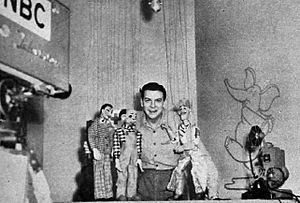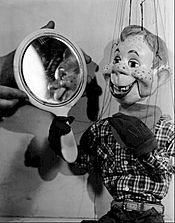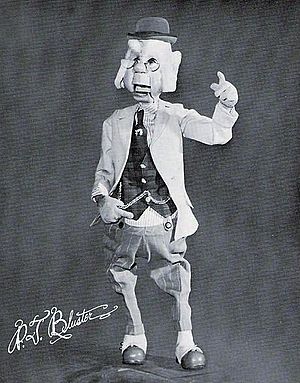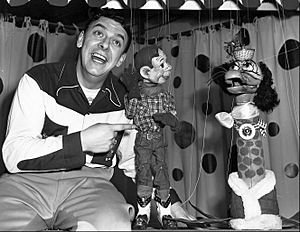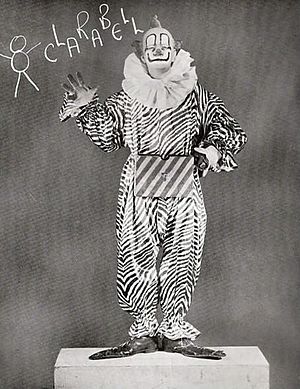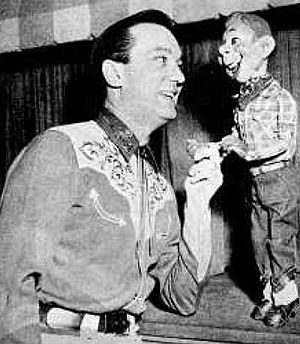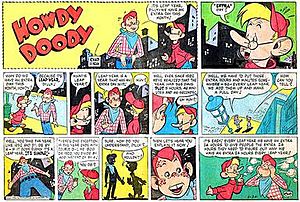Howdy Doody facts for kids
Quick facts for kids Howdy Doody |
|
|---|---|
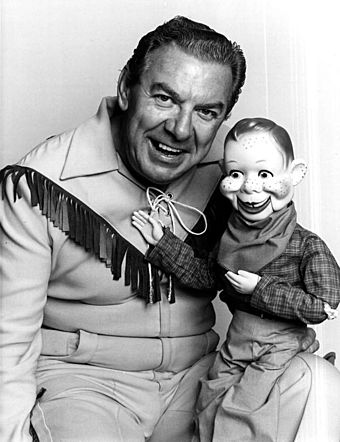
Buffalo Bob Smith and Howdy Doody in 1972
|
|
| Genre | Children's television series |
| Created by | E. Roger Muir |
| Presented by | Buffalo Bob Smith Howdy Doody |
| Starring | Bob Keeshan Lew Anderson Bobby Nicholson |
| Country of origin | United States |
| Production | |
| Producer(s) | E. Roger Muir and Nick Nicholson |
| Running time | 60 minutes (1947–1948, 1960) 30 Minutes (1948–1960) |
| Release | |
| Original network | NBC |
| Picture format | Black & White (1947–1955) Color (1955-1960) |
| Original release | December 27, 1947 – September 24, 1960 |
Howdy Doody is an American children's television program (with circus and Western frontier themes) that was created and produced by E. Roger Muir and telecast on the NBC network in the United States from December 27, 1947, until September 24, 1960. It was a pioneer in children's television programming and set the pattern for many similar shows. One of the first television series produced at NBC in Rockefeller Center, in Studio 3A, it was also a pioneer in early color production as NBC (at the time owned by TV maker RCA) used the show in part to sell color television sets in the 1950s.
Contents
Characters and story
Buffalo Bob Smith created Howdy Doody during his days as a radio announcer on WNBC. At that time, Howdy Doody was only a voice Smith performed on the radio. When Smith made an appearance on NBC's television program Puppet Playhouse on December 27, 1947, the reception for the character was great enough to begin a demand for a visual character for television. Frank Paris, a puppeteer whose puppets appeared on the program, was asked to create a Howdy Doody puppet.
Bob Smith, the show's host, was dubbed "Buffalo Bob" early in the show's run (a reference both to the historical American frontier character Buffalo Bill and Smith's hometown of Buffalo, N.Y.). At first the set was supposed to be a circus tent, but soon was changed to a western town. Smith wore cowboy garb, as did the puppet. The name of the puppet "star" was derived from the American expression "howdy doody"/"howdy do," a commonplace corruption of the phrase "How do you do?" used in the western United States. (The straightforward use of that expression was also in the theme song's lyrics.) Smith, who had gotten his start as a singing radio personality in Buffalo, frequently used music in the program. Cast members Lew Anderson and Robert "Nick" Nicholson both were experienced jazz musicians.
As both the character and television program grew in popularity, demand for Howdy Doody-related merchandise began to surface. By 1948, toymakers and department stores had been approached with requests for Howdy Doody dolls and similar items. Macy's department store contacted Frank Paris, the creator of the puppet, to ask about rights for a Howdy Doody doll. However, while Paris had created the puppet, Bob Smith owned the rights to the character. An argument ensued between the two men, Paris claiming he felt he was being cheated out of any financial benefits. After one such disagreement, Paris took the puppet and angrily left the NBC studios about four hours before the show was to air live. It was not the first time this happened, leaving the live program with no "star".
With Paris's past disappearances, impromptu excuses regarding the whereabouts of Howdy Doody had been hastily concocted. This time, an elaborate explanation was offered—that Howdy was busy with the elections on the campaign trail. NBC hurriedly constructed a map of the United States, which allowed viewers, with the help of Smith, to learn where Howdy was on the road. The explanation continued that while on the campaign trail, Howdy decided to improve his appearance with some plastic surgery. This made it possible for the network to hire Disney animator Mel Shaw and his business partner Bob Allen to design (refer to U.S. Patent D156687 for a "new, original, and ornamental design" for the puppet) and Velma Wayne Dawson to build and operate a more handsome and appealing visual character than Paris' original, which had been called "the ugliest puppet imaginable" by Bob Smith. Since Paris did not provide the voice of the character, Howdy's voice would stay the same after his appearance changed. The puppet which is remembered as the "original" Howdy Doody replaced Paris's original.

Howdy Doody himself was a freckle-faced boy marionette with 48 freckles, one for each state of the union at the time of his creation (up until January 3, 1959, when Alaska became the 49th state), and originally was voiced by Buffalo Bob Smith. The Howdy Doody show's various marionettes were created and built by puppeteers Dawson, Scott Brinker (the show's prop man), and Rufus Rose throughout the show's run. The redheaded Howdy marionette on the original show was operated with 11 strings: two heads, one mouth, one eye, two shoulders, one back, two hands and two knees. Three strings were added when the show returned—two elbows and one nose. The original marionette now resides at the Detroit Institute of Arts. There were duplicate Howdy Doody puppets, designed to be used expressly for off-the-air purposes (lighting rehearsals, personal appearances, etc.), although surviving kinescope recordings clearly show that these duplicate puppets were indeed used on the air occasionally. "Double Doody", the Howdy stand-in puppet, now is in the collection of the Division of Culture and the Arts at the Smithsonian National Museum of American History.
Photo Doody is the near-stringless marionette that was used in personal appearances, photos, parades, and the famed NBC test pattern. He was sold by Leland's Sports Auction House in 1997 for more than $113,000 to a private art collector, TJ Fisher.
Characters
Puppet characters
Besides Howdy Doody, the other characters in this show are:
- Heidi Doody: Introduced as a stranger who saved Buffalo Bob's life in Africa, she was adopted as Howdy's sister.
- Phineas T. Bluster: The resident skinflint, mayor of Doodyville and nemesis of Howdy; one of the Bluster triplets.
- Petey Bluster: Phineas's nephew.
- Don José Bluster: The South American Bluster brother.
- Thaddeus Bluster. Another Bluster brother?
- Hector Hamhock Bluster: The British Bluster brother
- Princess SummerFallWinterSpring: Introduced as a puppet, then played by actress Judy Tyler, who afterwards appeared opposite Elvis Presley in the 1957 film Jailhouse Rock. After she was killed in a car accident on July 3, 1957, at the age of 24, the character was portrayed by a marionette.
- Dilly Dally: Howdy's naive boyhood friend.
- Inspector John J. Fadoozle: "America's No. 1 private eye" whose character was revealed as the mysterious "Mr. X" who used the pseudonym to run against Howdy for the office of President of All the Boys and Girls of America; children could vote by using ballots that were attached to the wrappers of loaves of Wonder Bread, a major sponsor of the show.
- Chief Thunderthud and Chief Featherman: Two of several Native American characters used to emphasize the show's western theme.
- J. Cornelius Cobb: The shopkeeper played by Nick Nicholson, who had a strong dislike for clowns.
- Sandra the Witch
- Capt. Windy Scuttlebut
- Flub-a-Dub: A combination of eight animals. He had a duck's bill, a cat's whiskers, a spaniel's ears, a giraffe's neck, a dachshund's body, a seal's flippers, a pig's tail, and an elephant's memory.
Animal puppets
The show also featured animal puppets such as:
- Hyde and Zeke: Twin bears.
- Mambo: An African elephant.
- Tizzy: A dinosaur.
- Paddle: A gnu.
- Tommy Turtle: A slow-talking turtle who is not very bright.
Human characters
There also were several human characters, most notably:
- The mute Clarabell the Clown, who communicated in mime, by honking horns on his belt, and by squirting seltzer. Originally played by Bob Keeshan, who went on to create the children's TV character Captain Kangaroo. He was later played by Robert "Nick" Nicholson and finally by Lew Anderson. Clarabell didn't talk because he would have to be paid scale, and it was a low budget show.
- J. Cornelius Cobb, played by "Nick" Nicholson concurrently with the role of Clarabell and then exclusively when Lew Anderson took over the Clarabell role.
- Sir Archibald (played by Dayton Allen): An explorer.
- Chief Thunderthud (portrayed by Bill Le Cornec): Head of the Ooragnak (kangaroo spelled backward) tribe of American Indians. Edward Kean originated Thunderthud's greeting "Kowabonga!"—a nonsense word that eventually became part of the California surfer culture lexicon.
- Princess Summerfall Winterspring (portrayed by Judy Tyler): As a teenager, Tyler began her career with this supporting role, which she played from 1950 to 1953. The opportunity led to Tyler breaking out to starring roles on Broadway and eventually Hollywood, where she notably co-starred with Elvis Presley in Jailhouse Rock before dying in a 1957 auto accident.
The characters inhabited the fictional town of Doodyville. Several characters (including Ugly Sam, the world's worst wrestler, and Pierre the Chef) were played by comedian Dayton Allen, who later went on to become a cast regular on NBC's primetime The Steve Allen Show.
The Howdy show's non-televised rehearsals were renowned for including considerable double-entendre dialogue between the cast members (particularly the witty Dayton Allen) and the puppet characters. Corny Cobb was played by Bobby "Nick" Nicholson in 1952, by puppeteer Rufus Rose in 1953 and 1954 while Nicholson assumed the role of Clarabell, and again by Nicholson from early 1955 until the end of the show.
Clarabell was first played by Bob Keeshan (who also played The Featherman). Keeshan continued in that role until December 1952, when he, Dayton Allen, puppeteer Rhoda Mann, and Bill LeCornec left the show over a salary dispute. The role of Clarabell was then taken by Nicholson, who played it for about 22 months. In January 1955, the role was turned over to Anderson, who kept it until the series ended and for all subsequent revivals and specials, while Nicholson took on the role of J. Cornelius "Corny" Cobb. At the end of the final episode, telecast on September 24, 1960, Clarabell broke his series-long silence to say the final words of the final broadcast: "Goodbye, kids." Each of the cast members also played other roles as required.
Dolls
Howdy Doody dolls were also sold commercially, as well as marionettes of Howdy Doody and Flub-a-dub. There were also two other marionettes, Don José, and Hector Hamhock Bluster, brothers of Phineas T.
Replicas of Howdy
In addition to the original vintage puppets, puppetmaker Alan Semok (at the request of Bob Smith in the early 1990s) created several precise replicas of Howdy, including—thanks to improved materials and new molding techniques—a more exact marionette replica than had ever been produced, as well as a new Photo Doody which Smith used in personal appearances until his death from cancer on July 30, 1998, at the age of 80. One of Semok's marionette duplicates appears on a 2005 cover of TV Guide magazine as part of a series recreating classic covers from the magazine's history. The cover featured Howdy with TV host Conan O'Brien dressed as Buffalo Bob Smith. Another of the Semok duplicates resides in the International Museum and Library of the Conjuring Arts, the private museum owned by renowned illusionist David Copperfield.
Custody battle
After the death of Bob Smith, a fierce legal and custody battle for the original Howdy Doody puppet erupted among his heirs, the Rufus Rose estate, and a museum to which the marionette had been bequeathed. Howdy once again was in the news, with his face and story making headline broadcast, wire, talk show and print news around the world. For a while, during the tug-of-war fight, the puppet was held in a bank safe deposit box while the saga played out in the federal courts.
During one day of deposition, puppetmaker Semok (who had performed various maintenance and re-painting of the original Howdy marionette beginning in 1989) was called upon to unseal a trap door on the back of the puppet's head; Velma Dawson, the puppet's original builder, who was 88 at the time of the deposition, was present and given the opportunity to examine the inside of the head in an effort to verify that the puppet in question was the original she created. Despite 50 years of numerous repairs, repaints, and replaced body parts, Dawson eventually declared the head of the puppet to be the one she originally made in 1948. The Detroit Institute of Arts ultimately prevailed and has custody of the original Howdy.
Peanut gallery
A distinctive feature was the Peanut Gallery, onstage bleachers seating about 40 children. Each show began with Buffalo Bob asking, "Say kids, what time is it?" and the kids yelling in unison, "It's Howdy Doody Time!" Then the kids sang the show's theme song (set to the tune of "Ta-ra-ra Boom-de-ay"):
- It's Howdy Doody time,
- It's Howdy Doody time,
- Bob Smith and Howdy, too,
- Say "Howdy do" to you.
- Let's give a rousing cheer
- ’Cause Howdy Doody's here.
- It's time to start the show
- So kids, let's go!
It was, thus, one of the first television shows with audience participation as a major component.
In many of the 1949–1954 episodes released on DVD by Mill Creek Entertainment in 2008, the children also can be heard singing jingles for commercial breaks, with Buffalo Bob or Howdy leading them and the lyrics appearing on screen. Colgate toothpaste, Halo Shampoo, 3 Musketeers candy bars and Poll Parrot Shoes are among the products advertised this way, as well as series-long sponsor Wonder Bread.
The popularity of Howdy Doody and its Peanut Gallery led executives at United Features Syndicate to use the name Peanuts for syndication of Charles M. Schulz's Li'l Folks comic strip, reportedly to the lifelong chagrin of Schulz.
Smith's absence
In September 1954, Bob Smith suffered a heart attack and was ordered to recuperate at home. NBC managed to keep the show going with guest hosts, including Gabby Hayes and New York disc jockey Ted Brown as Bison Bill, explaining to kids that Smith was vacationing at Pioneer Village. While kids generally were satisfied with the explanation, show sponsors insisted they wanted Smith himself to hawk their products. In response, NBC set up a special studio at Smith's home so he could appear live "from Pioneer Village" to do commercials. During Smith's absence from the show, Howdy was voiced by Allen Swift. Swift continued to voice the character for the remainder of the show's run, even after Smith's return in September 1955.
Final episode
The final episode, "Clarabell's Big Surprise", was broadcast on September 24, 1960. The hour-long episode was mostly a fond look back at all the highlights of the show's past. Meanwhile, in the midst of it all, Clarabell has what he calls a "big surprise." The rest of the cast attempts to find out the surprise throughout the entire show, with only Mayor Phineas T. Bluster succeeding, and promising to keep it a secret. ("But", he says upon leaving, "it's not gonna be easy to keep a secret like this!")
Finally, in the closing moments, the surprise was disclosed through pantomime to Buffalo Bob and Howdy Doody; as it turned out, Clarabell the mute clown actually could talk. Amazed, Bob frantically told Clarabell to prove it, as this was his last chance. An ominous drum roll began as Clarabell faced the camera as it came in for an extreme closeup. His lips quivered as the drumroll continued. When it stopped, Clarabell simply said softly, "Goodbye, kids." A tear could be seen in his right eye as the picture faded to black, and some children in the Peanut Gallery could faintly be heard sobbing immediately before the credits music played.
The show quietly ended with a roll of credits over an empty, darkened set as "Auld Lang Syne" was played on a celeste, followed by an announcement that The Shari Lewis Show would be seen in its place at that time next week, followed by a spot for the TV series National Velvet.
The restored color videotape of the final broadcast is nowadays available commercially.
Merchandising and licensing
A 1955 merchandise catalog had 24 pages showcasing the range of products licensed by the show. The extensive merchandising included the aforementioned puppet, toys and clothing, plus tie-ins with cereals and other food products. Dell published a comic book from 1950 to 1956 along with Little Golden Books and Tell-a-Tale books, many written by Doody head writer Edward Kean. In addition Dell scribe John Stanley contributed scripts for the comic book. Kean also did some scripting (along with Stan Lee) of a Sunday-only Doody comic strip through United Feature Syndicate which ran from October 15, 1950, to June 21, 1953. Milt Neil and Chad Grothkopf were the initial art team through December 3, 1950 after which Grothkopf handled the art solo.
Cartoon
UPA was hired to do an animated cartoon (Howdy Doody and his Magic Hat) which was the first directorial effort of Gene Deitch and long thought lost until a print turned up at the Library of Congress in 2010. On April 15 of that year, the film was posted online.
Howdy Doody's return
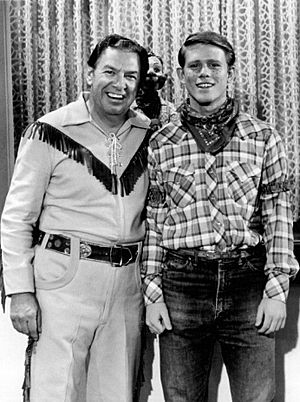
The 1970s brought a wave of nostalgia interest in an idealized representation of the 1950s, and with its films such as American Graffiti and the TV show Happy Days. An episode of Happy Days was entitled "The Howdy Doody Show" (number 33 of the series; original airdate February 18, 1975), during the series' second season, having a Howdy Doody storyline featuring Smith as Buffalo Bob with actor Bob Brunner as Clarabell.
The New Howdy Doody Show
Shortly thereafter, Nicholson-Muir Productions (owned by Nick Nicholson and E. Roger Muir) acquired from NBC the rights to produce the New Howdy Doody Show, an attempt by Buffalo Bob and most of the old cast to recreate their past fame. For this incarnation, which aired in first-run syndication, the Howdy Doody marionette had actual hair in a contemporary 1970s style and was operated by puppeteer Pady Blackwood.
Cast members included:
- Nicholson Muir (portrayed by Bill LeCornec): The flamboyant fictional producer of the show. He is named for the production company.
- Corny Cobb (portrayed by Nick Nicholson): He is now working as a "prop man" rather than a shopkeeper.
- Jackie Davis (Himself): The band leader.
- Happy Harmony (portrayed by Marilyn Patch, then Dr. Marilyn Plavocos Arnone): A teacher in Doodyville who fills in the same role as the Princess SummerFallWinterSpring character.
- Lew Anderson returned as Clarabell.
Crew members;
- Art Director- Milt Neal
- Costumer- Valerie E. Naiman
It was staged before a larger Peanut Gallery of children and their parents, originating from and taped in Florida. The revived series was not as successful as its predecessor, lasting only 130 episodes; the show debuted at the start of August 1976 and was canceled six months later at the end of January 1977.
Reruns of the show later aired on Sundays on Cozi TV. Recently, Amazon Prime began offering 20 episodes online.
It's Howdy Doody Time: A 40-Year Celebration
A decade later, the show celebrated its 40th anniversary with a two-hour syndicated TV special, It's Howdy Doody Time: A 40-Year Celebration, featuring Smith, Anderson, Nicholson and LeCornec, who reprised his former role of Chief Thunderthud.
Late in life, Bob Smith befriended New York-based fan Jack Roth, who already was quite familiar with Smith's gallery of puppet characters. Since Smith's death in 1998, Roth usually has provided the voice for Howdy in TV appearances and live venues. Actor-puppeteer Alan Semok, who was approached by Smith to re-create the Howdy marionette, also has voiced Howdy.
International versions
Like the later Sesame Street, Canadian, Cuban, and Mexican spin-off shows were licensed using local casts and duplicate puppets.
La Hora de Jaudi Dudi
In March 1953, the Kagran Corporation, the organization which produced the original Howdy Doody for NBC, started production on La Hora de Jaudi Dudi, a daily Spanish-language version of the programme filmed in Mexico City. The program aired over Canal de las Estrellas in Mexico and, beginning on April 27, CMQ-TV in Havana, Cuba. According to Billboard, the series featured a freckle-less Howdy puppet and a new puppet named Don Burro. While the aim was to produce a series to distribute to the entirety of Latin America, the company halted production after six months due to unforeseen production difficulties (At the time, Mexican television programming was scarce and often improvised, unlike the American-influenced Cuban market, apart from the fact that Mexican broadcasters weren't interested in foreign production) and market considerations (Until 1960, most South American countries did not have television services or supermarkets—by 1953, the only ones in the region were located in Havana and Lima, Peru-). 96 half-hour episodes were filmed.
Cuban television later launched its own local version, named Chiriltin, which lasted through 1959 or early 1960.
The Canadian Howdy Doody Show
The Canadian Howdy Doody Show was produced by the Canadian Broadcasting Corporation, and first aired on November 15, 1954. The CBC built its own Doodyville in a Toronto studio, and the show was set in Canada’s north. It was more low-budget than its American counterpart, with less raucous plots and less villainous villains, as well as a more educational orientation.
Most of the puppet characters, including Phineas T. Bluster, the cranky mayor and chief killjoy of Doodyville, Dilly Dally, a foolish carpenter who was usually the butt of Bluster's plots, Flub-a-dub, a beast with a duck's head, cat's whiskers, and the parts of several other animals, Heidi Doody, Howdy's sister, and Howdy himself, of course, were retained from the U.S. production.
But It had some major differences from its American cousin. Other puppets included Percival, a parrot, and Mr. X, who zipped through time and space in his "whatsis box." The show had Howdy and Clarabell, but most of the human performers differed in the CBC version. There was no Buffalo Bob, for instance. The show's host was Timber Tom, a forest ranger, played by Peter Mews.
Mews later appeared in the films The Unforeseen, Folio and First Performance. He also appeared on television in the 1954 production of Delilah, and the 1974 mini-series The National Dream. One of his most notable works was as Matthew Cuthbert in the Charlottetown Festival’s production of Anne of Green Gables, which he played for over twenty years. Peter Mews passed away on November 24, 1984, at the age of 63.
Clarabell was played by Alfie Scopp. Like the American Clarabell, he communicated in mime, by honking horns on his belt, and by squirting seltzer.
Scopp was born in London England in 1919, and came to Canada with his family when they immigrated to Montreal. Scopp has had a long and glorious career in both television and film. One of his most notable roles was the bookseller Avram in the 1971 film Fiddler on the Roof. He is also known for being the voice of “Charlie-in-the-Box” on the 1964 television Christmas special, Rudolph the Red-Nosed Reindeer.
Toby Tarnow played Princess Pan of the Forest, generally referred to as Pan. Tarnow was born in Gravelbourg Saskatchewan in 1937. She started studying acting at the Lorne Green Academy of Radio Arts at the age of eight, and by the age of ten she was already performing professionally on CBC radio. In 1954, she became the first actress to play Anne in the live televised production of the musical adaptation of Anne of Green Gables.
Following her role as Princess Pan on Howdy Doody, she had a recurring role on the CBC children’s program Mr. Dressup (the spinoff from Fred Rogers’ Misterrogers, after he took his neighborhood to Pittsburgh). Tarnow’s wide career encompassed radio, television, film, theater, and writing.
After moving to the United States she founded the Riverbend School of Theater Arts for the Boys and Girls Club in New Hampshire. In 2010 she was awarded the Children and Youth Theater Award by the New Hampshire Theater Awards.
Barbara Hamilton was Willow the Witch, an absent-minded white witch with a good heart. Known for her work on Canadian stage and television, she was once labelled the funniest woman in Canada.
Born in Kingston Ontario, Hamilton attended the University of Toronto before embarking on a career in theatre arts. Her first big break came with a role in Arsenic and Old Lace at Toronto's historic Royal Alexandra Theatre. From there, she went on to perform in theatres across the country, in works that ranged from classical tragedies to modern comedies.
She originated the role of Marilla Cuthbert in both the Canadian and London West End productions of Anne of Green Gables, and was later a regular on the CBC’s Road to Avonlea, and appeared in many other roles in film and television.
Larry Mann played good-natured pirate Cap'n Scuttlebutt. In Canada, the Cap’n was a live character, unlike the American Cap’n, which was a puppet. Mann was also the voice of Flub-a-Dub on the show.
Larry Mann was one of those character actors whose face and acting you’d always recognized. Born in Toronto on December 18, 1922, Mann was a disc jockey on radio station 1050 CHUM before he began his acting career. In his four decades of performing, Mann’s many credits included Get Smart, Gunsmoke, The Man from Uncle, Hill Street Blues, and The Dukes of Hazzard, to mention just a few of his TV appearances. Two of his most prominent movie roles were In the Heat of the Night (1967) and The Sting (1973). Larry Mann passed away in Los Angeles California on January 6, 2014, at the age of 91.
Another famous person that appeared on the Canadian Howdy was the famous singer and later Broadway star Robert Goulet. He played the character Trapper Pierre.
The Canadian show had one other Princess, named Haida, who had the powers of a Medicine Man. The character was played by actress Caryl McBain. Other characters on the show included Jean Cavall as Papa La Touke and Drew Thompson as Mendel Mason.
Some sources credit James Doohan (Scotty on the original Star Trek) as being the first host of the show, playing Ranger Bill for a short time at the beginning of the series. As the story goes, after the chief forest ranger called him away to fight a forest fire in November 1954, Timber Tom, played by Peter Mews, took his place. However, in his autobiography, Doohan never credits himself in the role. And the show’s first public episode was November 15th. So his time on the show was probably very short-lived.
Another actress started out playing Princess Pan in 1954. That was Maxine Miller, who later went on to play Nurse Farmer in the first three seasons of Misterrogers, the previously-mentioned Canadian precursor to Mister Rogers’ Neighborhood in the U.S. She has since appeared in over 120 movies and television shows.
There was also another familiar Canadian actor who allegedly appeared on the Canadian Howdy Doody Show, and that was William Shatner (Star Trek’s Captain Kirk). There is some controversy as to whether he did or not, but some sources say that in 1954, he came on as the character Ranger Bob.
One of the shows characters was named Mr. X. Not to be confused with the American Howdy Doody character with the same name, the Canadian Mr. X would teach history to the children watching. To do so, he would travel through space and time in what he called his “Whatsis Box”. If this sounds familiar, one must point out that Sydney Newman, one of the Canadian show’s creators, later moved to England, where he help to create the BBC program Doctor Who.
The actors who voiced the different puppet characters on the Canadian Howdy Doody Show included Claude Rae (Howdy Doody, Phineas T. Bluster and Mr. X), Jacqueline White (Howdy Doody), Norma MacMillan (Heidi Doody), Donna Miller (Prunella Bluster and Heidi Doody), and Jack Mather (Dilly Dally, Percival Parrot, and other characters). And Larry Mann, who already had experience working with puppets with CBC’s Uncle Chichimus, was the voice of Flub-a-dub. The puppeteers who worked the strings were Hal and Renée Marquette.
In addition to the adventures of the citizens of Doodyville and the Peanut Gallery, the show also featured film presentation on nature or travel. The scripts were adapted by Cliff Braggins, who also wrote music for the show. Quentin Maclean provided organ music. The program was produced by Paddy Sampson. After nearly five years on the air, the CBC decided to cancel the show to develop children's programming of its own. The Canadian Howdy Doody’s last broadcast was on June 26, 1959.
Images for kids


